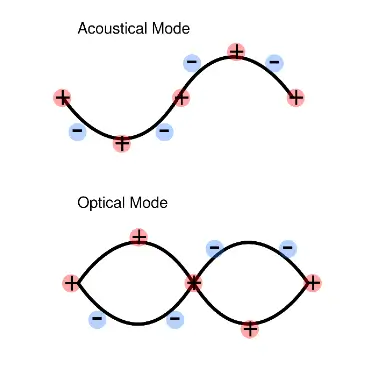In solid-state physics, a phonon is a quantised mode of vibration occurring in a rigid crystal lattice. Phonons are collective excitations in periodic, elastic arrangements of atoms or molecules in condensed matter, and they play a significant role in many physical properties of solids, such as thermal conductivity and electrical conductivity. Phonons can be thought of as the quantum mechanical version of normal modes of vibrations in classical mechanics.
Crystal Lattices and Vibrations
Atoms in a crystal lattice are arranged in a highly ordered, repeating pattern. The atoms interact with each other through interatomic forces, creating a potential energy landscape. At thermal equilibrium, the atoms are in their equilibrium positions, but they can still vibrate around these positions. These vibrations are not random but are instead organised into normal modes, where all atoms oscillate with the same frequency and phase.
Quantum Description of Vibrations
In the quantum mechanical framework, these vibrational modes are quantised. The quantisation leads to the concept of phonons, which are the discrete quanta of lattice vibrations. Each phonon represents a quantised unit of vibrational energy.
Types of Phonons
Phonons are typically categorised into two types based on the nature of the atomic displacements they represent:
1. Acoustic Phonons: These phonons correspond to sound waves propagating through the lattice. In acoustic modes, atoms move in phase, leading to a collective displacement similar to sound waves in air. There are typically three acoustic branches: one longitudinal acoustic (LA) and two transverse acoustic (TA) branches.

2. Optical Phonons: These phonons arise when atoms in the basis of the unit cell move relative to each other. In optical modes, neighbouring atoms move out of phase, leading to oscillations that can interact with electromagnetic waves, hence the name “optical”. Similar to acoustic phonons, there are longitudinal optical (LO) and transverse optical (TO) branches.
Phonon Dispersion Relations
The relationship between the phonon frequency and the wave vector (which describes the phonon’s wavelength and direction of propagation) is known as the phonon dispersion relation. The dispersion relation provides essential insights into the dynamic behaviour of the crystal lattice. For a simple one-dimensional monatomic lattice, the dispersion relation can be derived using the harmonic approximation and considering nearest-neighbour interactions.
Thermal Properties
Phonons play a crucial role in determining the thermal properties of solids. The thermal conductivity of a material is significantly influenced by phonon transport. At low temperatures, the specific heat of a solid is dominated by phonons and follows the Debye T^3 law, which can be explained using the concept of phonons.
- Specific Heat: The specific heat at constant volume (Cv) can be described using the Debye model, which treats phonons as a gas of non-interacting particles.
- Thermal Conductivity: Phonons carry thermal energy in insulators and semiconductors. The thermal conductivity depends on the phonon mean free path, which is affected by phonon-phonon interactions (Umklapp processes), phonon-electron interactions, and phonon-boundary scattering.
Electron-Phonon Interaction
In metals and semiconductors, the interaction between electrons and phonons is a fundamental process that affects electrical resistivity and superconductivity. The electron-phonon interaction leads to phenomena such as:
- Electrical Resistivity: Phonon scattering contributes to the electrical resistivity of metals. At higher temperatures, the resistivity increases due to more significant phonon activity.
- Superconductivity: In superconductors, electron-phonon interactions are crucial in the formation of Cooper pairs, leading to the phenomenon of superconductivity as described by the BCS (Bardeen-Cooper-Schrieffer) theory.
Phonon Scattering Mechanisms
Phonon scattering mechanisms affect the thermal and electrical properties of materials. Key scattering processes include:
- Phonon-Phonon Scattering: This includes normal (N-process) and Umklapp (U-process) scattering, where phonons scatter off each other, conserving or not conserving momentum, respectively.
- Phonon-Electron Scattering: Electrons can scatter off phonons, affecting electrical conductivity and thermal properties.
- Phonon-Defect Scattering: Imperfections in the crystal lattice, such as impurities or vacancies, can scatter phonons, affecting thermal conductivity.
Experimental Techniques
Several experimental techniques are used to study phonons in materials:
- Neutron Scattering: Neutron scattering experiments can measure phonon dispersion relations directly.
- Raman Spectroscopy: Raman scattering provides information on optical phonons and their interactions.
- Infrared Spectroscopy: Infrared absorption measurements can probe optical phonons.
Conclusion
Phonons are fundamental to the understanding of various physical properties of materials in solid-state physics. From thermal conductivity to electrical resistivity, the behaviour of phonons underpins much of the macroscopic behaviour of solids. The study of phonons not only enhances our comprehension of material properties but also drives advancements in technology, such as thermoelectric materials, semiconductor devices, and superconductors. Through both theoretical and experimental approaches, researchers continue to uncover the complex and fascinating world of phonons.




